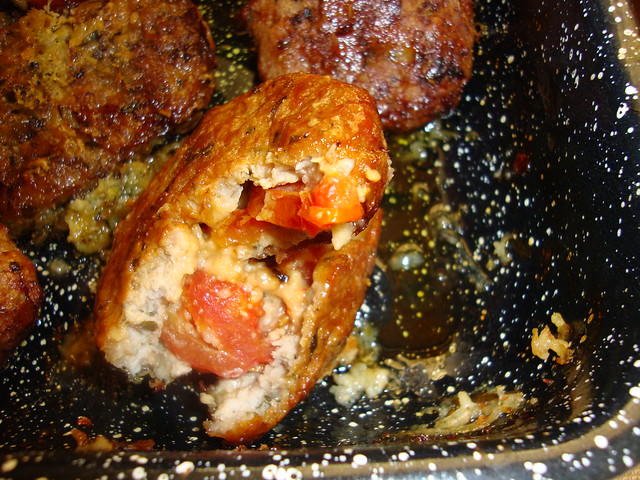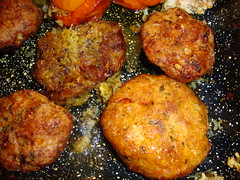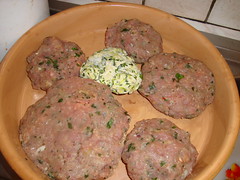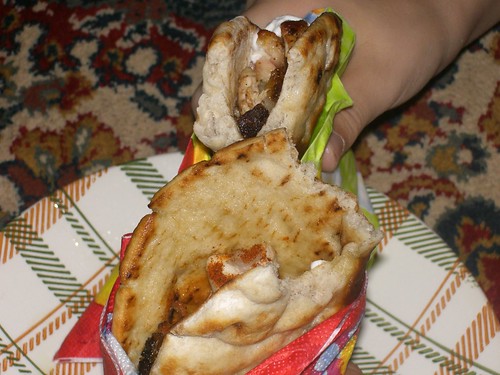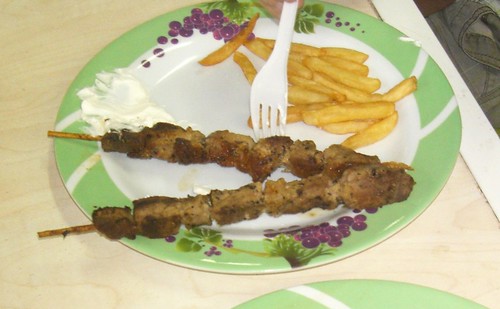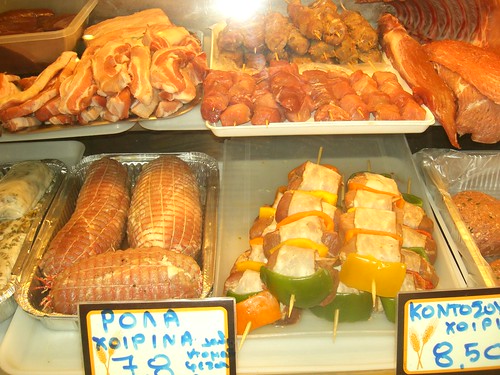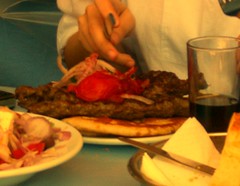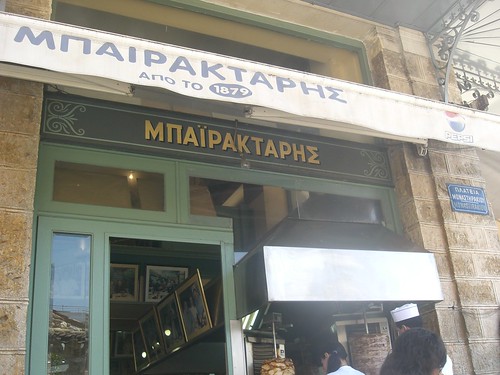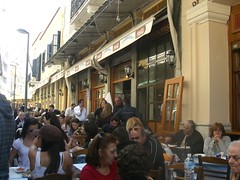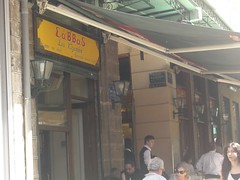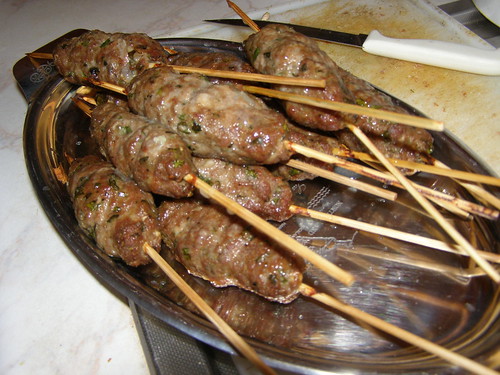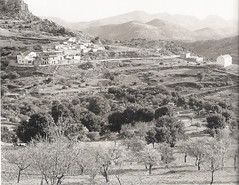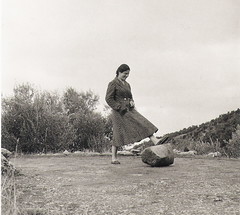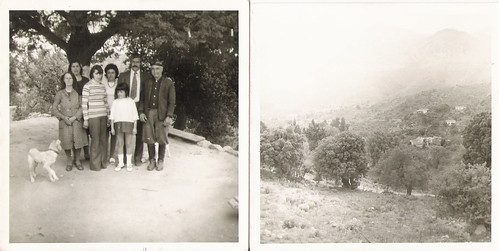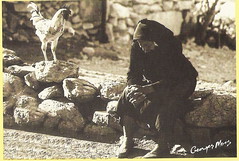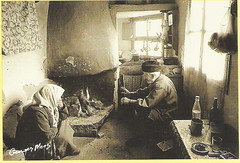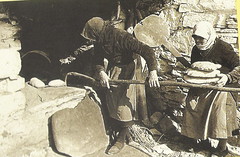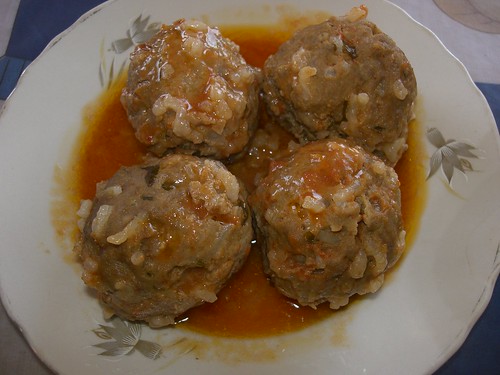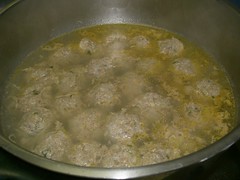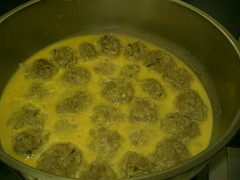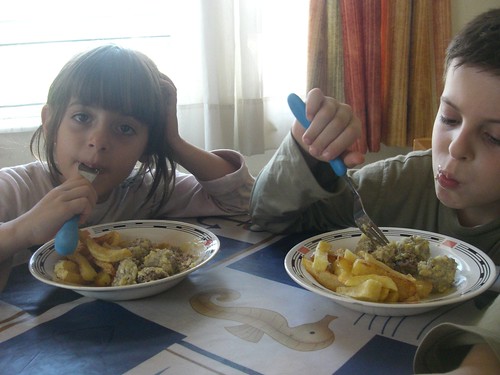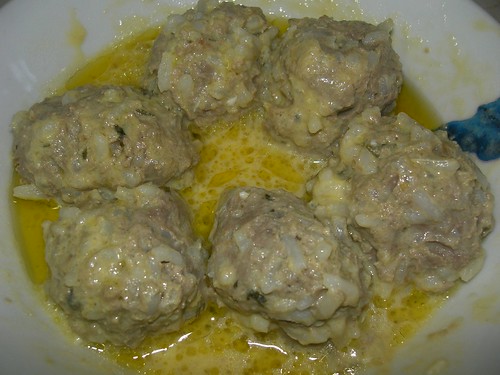I was buying some (French) beef the other day, which I asked to be turned into mince. The woman at the supermarket counter asked me what I was going to make.
"Bifteki for the freezer," I told her, "and I will also leave some to make a makaronada for tomorrow's lunch."
"If you have some cooked mince left over," she said to me, "use it in a melitzanopita." She explained that aubergine/eggplant pie was her favorite pita. Her mother in law introduced her to it recently, making it into a large pie (made with filo pastry) which she served up as a main meal with salad, as well as on a buffet table for a party. These days, her daughter in law makes it into little pies enclosed in thick pastry (made with puff pastry sheets) and she takes them to the beach as part of a picnic lunch. "They freeze really well, too," she added.
I'd never made eggplant pie before, although I have heard of eggplant used in similar ways, eg vegetarian patties and fritters. Looking it up in my Greek cookbooks, I came across a couple of recipes for eggplant pie, made by some famous old-school Greek TV chefs. They were labelled plainly - melitzanopita - but neither used mince in the recipe: they both used dairy products (cheese and cream). One version (1990) - made by Ilias Mamalakis, who stated that the recipe was given to him by Dimitris Bliziotis, a Greek food historian - was made into a large pie while the other (1999) - made by Vefa Alexiadou (no history of the origin is mentioned) was made into individual fat cigars. Both versions used different thicknesses of Greek filo pastry and the recipes were very frugal in nature, with a clear focus on simple Greek flavours. Ilia's pie contained just coriander seeds to flavour it, while Vefa's used parsley and mint. The basic idea was to make an eggplant filling for a simple pastry casing, which could be rolled up in any way that the cook felt like making them.
I thought this sounded like a nice novel way to use up the eggplant that is rolling into the house from our summer garden at the moment. It also sounded like something I would really like to make - when we hear of a new kind of food, we are open to it as long as it suits our taste spectra. Before looking up 'melitzanopita' (or 'eggplant pie', 'aubergine pie' etc) on the web - my first stop for anything that I don't know these days - I decided that it had to be a very Mediterranean taste combination, something that decidedly fits into the Greek taste spectrum. Melitzanopita sounds unusual, but the ingredients needed to make it are actually very common. Although the pie is not a well known Greek recipe, I bet that it must have been tried out at the very least on one of those morning TV shows that housewives watch, which screen while I'm at work. (By the time I come home, old Greek re-runs are playing, and then it's Turkish soap opera extravaganza time, as Greece can no longer afford to make her own.)
Sure enough, I came across a number of youtube videos from the private Greek TV channels, which often contain a mixture of make-you-feel-good topics for ladies of no particular occupation: a bit of fashion, some celeb gossip, a recipe by a home cook, with the show being hosted by strappy-dressed peroxide blondes. This kind of light-entertainment program features on most of the private channels, unlike the former Greek state broadcaster, still doing a pirate run on ebu.ch, which is now featuring no entertainment, and only political discussions, operatic music and other very politico-socio-cultural formal types of Greek-style urban-context amusement. (I am hard pressed to understand if the operatic bits are what rural Greeks expected to suddenly be bombarded with on the pirate ERT - then again, they probably don't use internet to watch anything, ergo... pirate ERT is broadcasting not for the masses, but the minority. And let's not talk about the new public but not-quite-legal broadcaster that hit Greek TV screens a couple of weeks ago - it's quite simply an embarrassment.)
The melitzanopita was made into what looked like a delicious vegetarian pie using soft white cheese and home-made pastry (ALPHA - June 2012). Admittedly, Vasilis Kalilidis made a really hash job of his pastry, but as I mention on my blog how trivial it is to worry about how perfect your filo pastry sheets come out: when you cut it, it's gonna get scrappy anyway, so the most important thing about making pastry is that your pie remains in one piece after it's cooked and you are serving it, whether on the plate or as finger food.
The next link I found came from - yet again - another TV morning show recipe featured on the web, only a week after the previous one (ANT1 - 12 June 2012). Argiro Barbaridou's melitzanopita did contain mince, but it was quite a 'heavy' recipe: it also contained eggs and cheese, which didn't entice me to make it, as I prefer my pies simpler. Eggs, cheese, mince and eggplant, covered in carb-filled pastry, all in one dish reminds me of very rich meals like moussaka, which are better eaten during the winter in colder weather.
But the chef who started this eggplant pie craze appeared a whole month before the vegetarian and meat version (SKAI - 8 May 2012) - George Gounaridis' melitzanopita is vegetarian (it contains cheese). That's what I love about cooking - making the same food in different ways, to satisfy different tastes. The well known restauranteur made his own thin (perfect) filo pastry which he layered into a baking tin with a simple filling of cooked eggplant, tomatoes and onions. The finished pie looked very light and very appetising.



So you get the picture: eggplant pie can be made any way you want - vegetarian or with meat, even vegan, with the addition of perhaps a binding agent (eg breadcrumbs, semolina or crushed nuts). The pastry can be home made or store bought, in any thickness. But the most important aspect is to make sure that the eggplant is prepared in some way before adding it to the pie. Either it is cooked in cubes, or it is cooked whole and the skin is scraped away before being used for the filling. Eggplant is one of those vegetables that needs a lot of olive oil to cook well enough not to taste like cardboard (which is probably why Gwyneth Paltrow doesn't like eggplant). To avoid the oil, it needs to be roasted. Either way, it needs some preparation time before being used in meals such as pies.
After deciding what kind of filling you want, and what kind of filo pastry you will end up using, you can then choose which shape of pita to use. Whether you make a large pie to cut into pieces, or you make individual pies is up to you. I decided to make my melitzanopita into 'snail pies' - an idea I found from yet another recent melitzanopita recipe from a well known Greek TV chef (no date is given for Dina Nikolaou's pie, but I suspect it was as recently as 1-2 years) - as I really like shaping filo in this way, and it cuts up nicely into smaller pieces, for good portion control.



While there is no shortage of melitzanopita recipes in Greek, eggplant pie is found in just a few non-Greek recipes. I have heard that Martha Stewart has some kind of Greek background, so I wonder if it was this aspect of her identity that drove her to make individual eggplant cheese pies in 2010. I think her vegetarian muffin-shaped melitzanopitakia look dreamy. Her recipe is not far off the one I used: I added strained cubed tomato, I didn't use coriander and I used crushed walnuts instead of pistachios. Crushed nuts are a great addition to pie fillings because they give pies an added texture, the nuts soak up excess liquids in a filling (the same job breadcrumbs and rice do) which often makes pastry soggy, and nuts act like protein in a vegetarian dish. The walnuts also had a sweetening effect on the eggplant, which can sometimes taste bitter, depending on the quality of the eggplant.
The important thing in an eggplant pie is not so much what you add to the filling, as much as the texture of the final filling. The creamier and firmer, the better, because it's easier to work with, and it cooks better. The fillings should be pre-cooked before being added to the pastry. I used Dina Nikolaou's recipe to make my vegetarian melitzanopita, while for the mince version, I simply fried some small cubes of eggplant in olive oil, drained them and then added them to some leftover makaronada mince. That constituted my meat-eggplant filling. Both pies worked well because the eggplant was paired with classic Mediterranean tastes. It all depends on what you want to make, how you want to make it, and the desired finished look of the pie.

©All Rights Reserved/Organically cooked. No part of this blog may be reproduced and/or copied by any means without prior consent from Maria Verivaki.
"Bifteki for the freezer," I told her, "and I will also leave some to make a makaronada for tomorrow's lunch."
"If you have some cooked mince left over," she said to me, "use it in a melitzanopita." She explained that aubergine/eggplant pie was her favorite pita. Her mother in law introduced her to it recently, making it into a large pie (made with filo pastry) which she served up as a main meal with salad, as well as on a buffet table for a party. These days, her daughter in law makes it into little pies enclosed in thick pastry (made with puff pastry sheets) and she takes them to the beach as part of a picnic lunch. "They freeze really well, too," she added.
I'd never made eggplant pie before, although I have heard of eggplant used in similar ways, eg vegetarian patties and fritters. Looking it up in my Greek cookbooks, I came across a couple of recipes for eggplant pie, made by some famous old-school Greek TV chefs. They were labelled plainly - melitzanopita - but neither used mince in the recipe: they both used dairy products (cheese and cream). One version (1990) - made by Ilias Mamalakis, who stated that the recipe was given to him by Dimitris Bliziotis, a Greek food historian - was made into a large pie while the other (1999) - made by Vefa Alexiadou (no history of the origin is mentioned) was made into individual fat cigars. Both versions used different thicknesses of Greek filo pastry and the recipes were very frugal in nature, with a clear focus on simple Greek flavours. Ilia's pie contained just coriander seeds to flavour it, while Vefa's used parsley and mint. The basic idea was to make an eggplant filling for a simple pastry casing, which could be rolled up in any way that the cook felt like making them.
 |
| Ilias' (left) and Vefa's (right) melitzanopita recipes |
Sure enough, I came across a number of youtube videos from the private Greek TV channels, which often contain a mixture of make-you-feel-good topics for ladies of no particular occupation: a bit of fashion, some celeb gossip, a recipe by a home cook, with the show being hosted by strappy-dressed peroxide blondes. This kind of light-entertainment program features on most of the private channels, unlike the former Greek state broadcaster, still doing a pirate run on ebu.ch, which is now featuring no entertainment, and only political discussions, operatic music and other very politico-socio-cultural formal types of Greek-style urban-context amusement. (I am hard pressed to understand if the operatic bits are what rural Greeks expected to suddenly be bombarded with on the pirate ERT - then again, they probably don't use internet to watch anything, ergo... pirate ERT is broadcasting not for the masses, but the minority. And let's not talk about the new public but not-quite-legal broadcaster that hit Greek TV screens a couple of weeks ago - it's quite simply an embarrassment.)
 |
| Vegetarian filling for melitzanopita |
 |
| Melitzanopita with mince cooked eggplant and mince (made in the same way as for makaronada) |
But the chef who started this eggplant pie craze appeared a whole month before the vegetarian and meat version (SKAI - 8 May 2012) - George Gounaridis' melitzanopita is vegetarian (it contains cheese). That's what I love about cooking - making the same food in different ways, to satisfy different tastes. The well known restauranteur made his own thin (perfect) filo pastry which he layered into a baking tin with a simple filling of cooked eggplant, tomatoes and onions. The finished pie looked very light and very appetising.


Don't worry about how scrappy your pastry looks; it'll break up easily at any rate once it's cooked.

 |
| I decided to make my melitzanopita in the shape of a 'snail pie.' |



Sarikopita, Strifti, Kihi - they are all names for a round pie made up of pieces of filled pastry made in the shape of a snail's shell.
While there is no shortage of melitzanopita recipes in Greek, eggplant pie is found in just a few non-Greek recipes. I have heard that Martha Stewart has some kind of Greek background, so I wonder if it was this aspect of her identity that drove her to make individual eggplant cheese pies in 2010. I think her vegetarian muffin-shaped melitzanopitakia look dreamy. Her recipe is not far off the one I used: I added strained cubed tomato, I didn't use coriander and I used crushed walnuts instead of pistachios. Crushed nuts are a great addition to pie fillings because they give pies an added texture, the nuts soak up excess liquids in a filling (the same job breadcrumbs and rice do) which often makes pastry soggy, and nuts act like protein in a vegetarian dish. The walnuts also had a sweetening effect on the eggplant, which can sometimes taste bitter, depending on the quality of the eggplant.
 |
| The cooked pies - vegetarian (top) and mince (bottom) melitzanopita |

Vegan melitzanopita for the 2nd Symposium: Food, Memory and Identity in Greece and the Diaspora taking place this weekend. The filling contains the same ingredients as the Gounaridis pita without the cheese; instead, I added some green peppers (with the onion), and a mixture of breadcrumbs and walnuts to bind the (cooked pureed) filling. It smells like mince - very cheap, very Greek and very frugal (the whole thing can't have cost me more than €1.50 to make - all the ingredients are found in most Cretan homes, and half would come from a small summer garden).
Melitzanopita, as it is made by Greeks, from the recipes available on the web, fits well within the taste spectrum of Greek food, using commonly associated combinations in Greek cuisine: eggplant and mince or eggplant and tomato, spiced up with parsley and mint, dressed in olive oil and encased in classic Greek filo pastry. It is an aromatic pie and makes a full meal, coupled with a green salad and some wine. More importantly, it's not an acquired taste and it is very versatile; these two aspects will make it popular among a wide variety of people.©All Rights Reserved/Organically cooked. No part of this blog may be reproduced and/or copied by any means without prior consent from Maria Verivaki.













